Adult Nursing: Learning Theories in Female Catheterization Report
VerifiedAdded on 2020/04/21
|18
|4545
|121
Report
AI Summary
This report delves into the process of female catheterization within the context of adult nursing, focusing on the learning theories and methodologies employed to teach this critical skill. It examines the use of visual and aural presentations, the application of cognitive and social learning theories, and the role of observational learning. The report highlights the significance of the VAK questionnaire in identifying learning styles and discusses the reflector learner approach. It also explores the Bobo doll experiment as a teaching method and emphasizes the importance of mentor behavior and the learning environment. The report analyzes the advantages and disadvantages of each learning theory, offering insights into how nursing students acquire and refine skills in female catheterization. It also emphasizes the importance of motivation, reinforcement, and the role of practical demonstration and discussion in the learning process.

Running head: ADULT NURSING
Adult nursing
Name of the Student
Name of the University
Author note
Adult nursing
Name of the Student
Name of the University
Author note
Paraphrase This Document
Need a fresh take? Get an instant paraphrase of this document with our AI Paraphraser
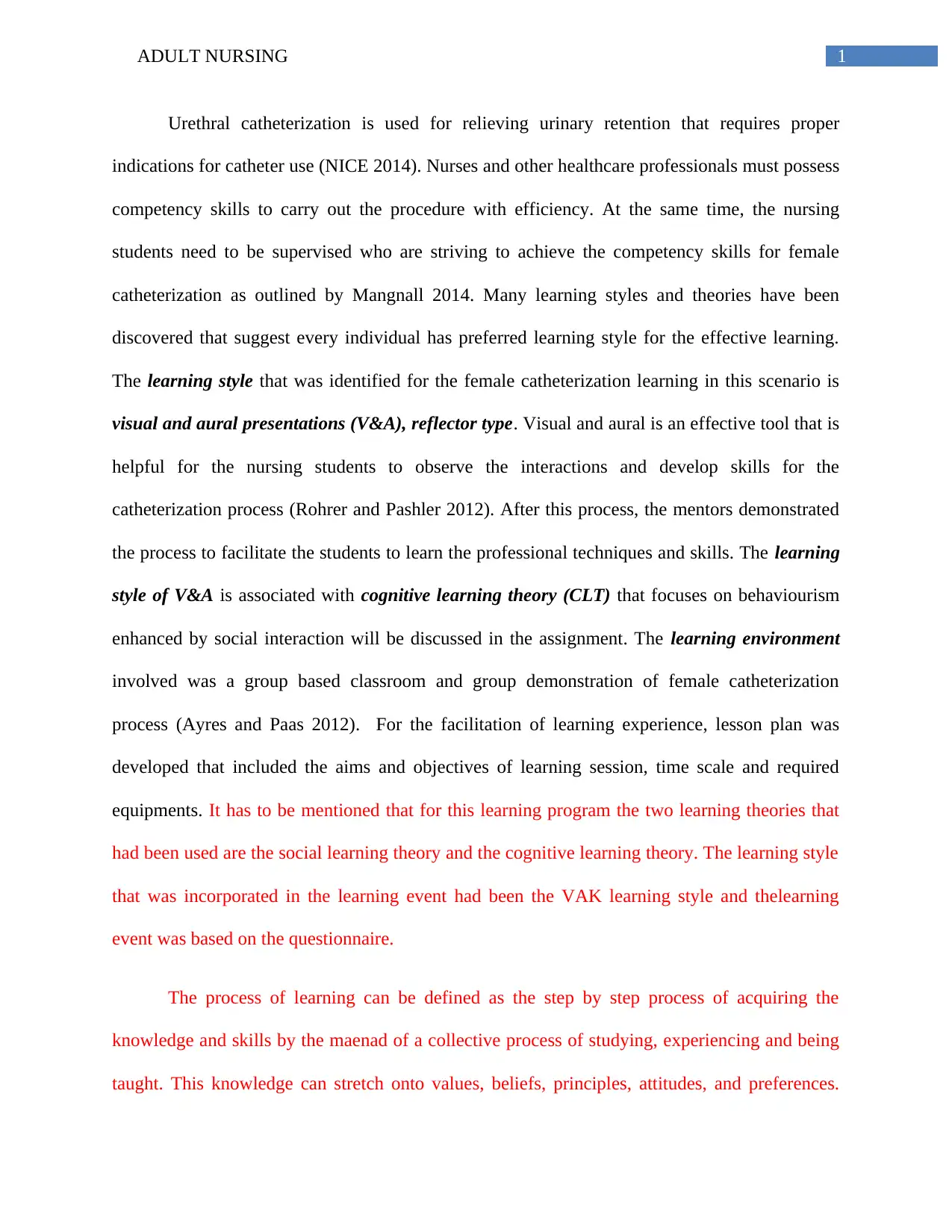
1ADULT NURSING
Urethral catheterization is used for relieving urinary retention that requires proper
indications for catheter use (NICE 2014). Nurses and other healthcare professionals must possess
competency skills to carry out the procedure with efficiency. At the same time, the nursing
students need to be supervised who are striving to achieve the competency skills for female
catheterization as outlined by Mangnall 2014. Many learning styles and theories have been
discovered that suggest every individual has preferred learning style for the effective learning.
The learning style that was identified for the female catheterization learning in this scenario is
visual and aural presentations (V&A), reflector type. Visual and aural is an effective tool that is
helpful for the nursing students to observe the interactions and develop skills for the
catheterization process (Rohrer and Pashler 2012). After this process, the mentors demonstrated
the process to facilitate the students to learn the professional techniques and skills. The learning
style of V&A is associated with cognitive learning theory (CLT) that focuses on behaviourism
enhanced by social interaction will be discussed in the assignment. The learning environment
involved was a group based classroom and group demonstration of female catheterization
process (Ayres and Paas 2012). For the facilitation of learning experience, lesson plan was
developed that included the aims and objectives of learning session, time scale and required
equipments. It has to be mentioned that for this learning program the two learning theories that
had been used are the social learning theory and the cognitive learning theory. The learning style
that was incorporated in the learning event had been the VAK learning style and thelearning
event was based on the questionnaire.
The process of learning can be defined as the step by step process of acquiring the
knowledge and skills by the maenad of a collective process of studying, experiencing and being
taught. This knowledge can stretch onto values, beliefs, principles, attitudes, and preferences.
Urethral catheterization is used for relieving urinary retention that requires proper
indications for catheter use (NICE 2014). Nurses and other healthcare professionals must possess
competency skills to carry out the procedure with efficiency. At the same time, the nursing
students need to be supervised who are striving to achieve the competency skills for female
catheterization as outlined by Mangnall 2014. Many learning styles and theories have been
discovered that suggest every individual has preferred learning style for the effective learning.
The learning style that was identified for the female catheterization learning in this scenario is
visual and aural presentations (V&A), reflector type. Visual and aural is an effective tool that is
helpful for the nursing students to observe the interactions and develop skills for the
catheterization process (Rohrer and Pashler 2012). After this process, the mentors demonstrated
the process to facilitate the students to learn the professional techniques and skills. The learning
style of V&A is associated with cognitive learning theory (CLT) that focuses on behaviourism
enhanced by social interaction will be discussed in the assignment. The learning environment
involved was a group based classroom and group demonstration of female catheterization
process (Ayres and Paas 2012). For the facilitation of learning experience, lesson plan was
developed that included the aims and objectives of learning session, time scale and required
equipments. It has to be mentioned that for this learning program the two learning theories that
had been used are the social learning theory and the cognitive learning theory. The learning style
that was incorporated in the learning event had been the VAK learning style and thelearning
event was based on the questionnaire.
The process of learning can be defined as the step by step process of acquiring the
knowledge and skills by the maenad of a collective process of studying, experiencing and being
taught. This knowledge can stretch onto values, beliefs, principles, attitudes, and preferences.
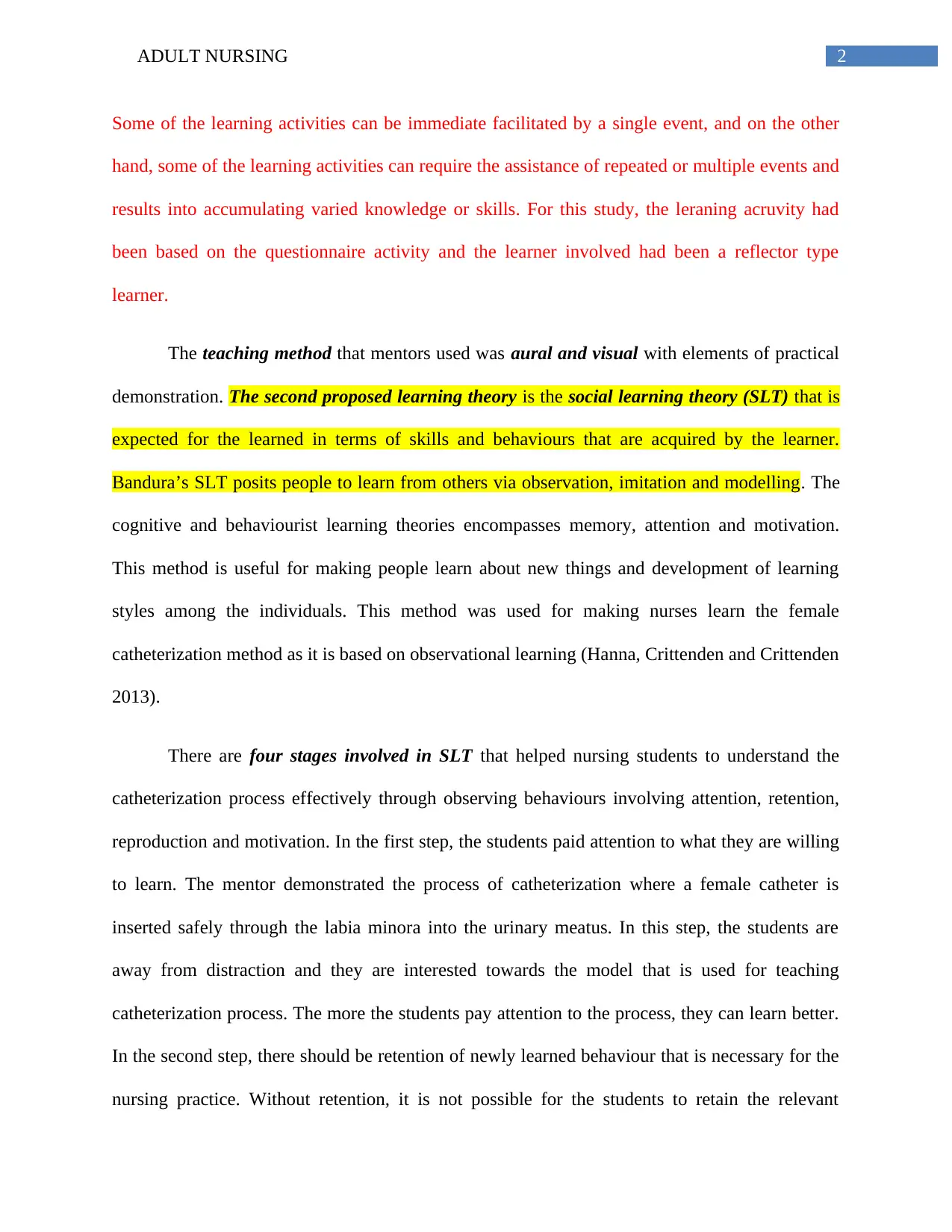
2ADULT NURSING
Some of the learning activities can be immediate facilitated by a single event, and on the other
hand, some of the learning activities can require the assistance of repeated or multiple events and
results into accumulating varied knowledge or skills. For this study, the leraning acruvity had
been based on the questionnaire activity and the learner involved had been a reflector type
learner.
The teaching method that mentors used was aural and visual with elements of practical
demonstration. The second proposed learning theory is the social learning theory (SLT) that is
expected for the learned in terms of skills and behaviours that are acquired by the learner.
Bandura’s SLT posits people to learn from others via observation, imitation and modelling. The
cognitive and behaviourist learning theories encompasses memory, attention and motivation.
This method is useful for making people learn about new things and development of learning
styles among the individuals. This method was used for making nurses learn the female
catheterization method as it is based on observational learning (Hanna, Crittenden and Crittenden
2013).
There are four stages involved in SLT that helped nursing students to understand the
catheterization process effectively through observing behaviours involving attention, retention,
reproduction and motivation. In the first step, the students paid attention to what they are willing
to learn. The mentor demonstrated the process of catheterization where a female catheter is
inserted safely through the labia minora into the urinary meatus. In this step, the students are
away from distraction and they are interested towards the model that is used for teaching
catheterization process. The more the students pay attention to the process, they can learn better.
In the second step, there should be retention of newly learned behaviour that is necessary for the
nursing practice. Without retention, it is not possible for the students to retain the relevant
Some of the learning activities can be immediate facilitated by a single event, and on the other
hand, some of the learning activities can require the assistance of repeated or multiple events and
results into accumulating varied knowledge or skills. For this study, the leraning acruvity had
been based on the questionnaire activity and the learner involved had been a reflector type
learner.
The teaching method that mentors used was aural and visual with elements of practical
demonstration. The second proposed learning theory is the social learning theory (SLT) that is
expected for the learned in terms of skills and behaviours that are acquired by the learner.
Bandura’s SLT posits people to learn from others via observation, imitation and modelling. The
cognitive and behaviourist learning theories encompasses memory, attention and motivation.
This method is useful for making people learn about new things and development of learning
styles among the individuals. This method was used for making nurses learn the female
catheterization method as it is based on observational learning (Hanna, Crittenden and Crittenden
2013).
There are four stages involved in SLT that helped nursing students to understand the
catheterization process effectively through observing behaviours involving attention, retention,
reproduction and motivation. In the first step, the students paid attention to what they are willing
to learn. The mentor demonstrated the process of catheterization where a female catheter is
inserted safely through the labia minora into the urinary meatus. In this step, the students are
away from distraction and they are interested towards the model that is used for teaching
catheterization process. The more the students pay attention to the process, they can learn better.
In the second step, there should be retention of newly learned behaviour that is necessary for the
nursing practice. Without retention, it is not possible for the students to retain the relevant
⊘ This is a preview!⊘
Do you want full access?
Subscribe today to unlock all pages.

Trusted by 1+ million students worldwide
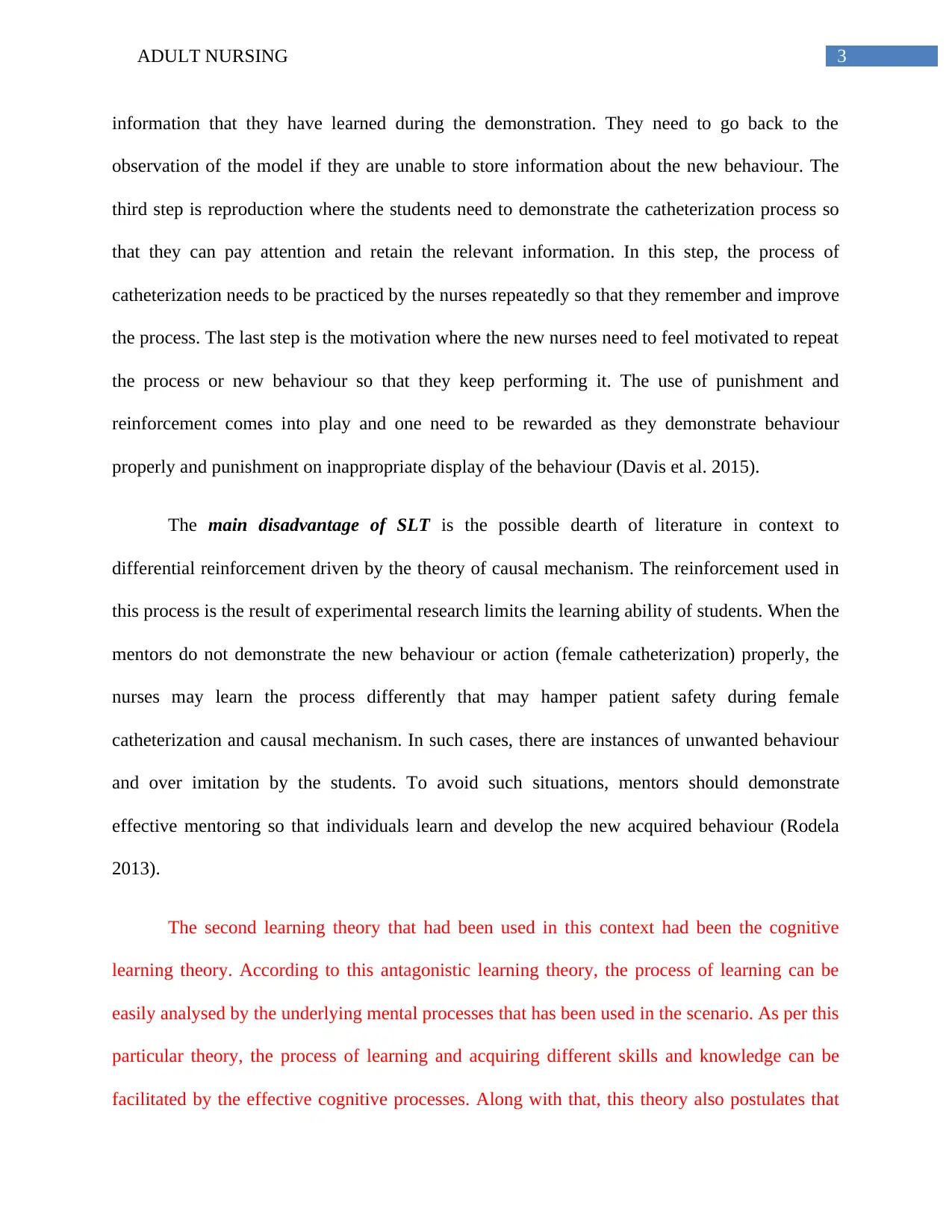
3ADULT NURSING
information that they have learned during the demonstration. They need to go back to the
observation of the model if they are unable to store information about the new behaviour. The
third step is reproduction where the students need to demonstrate the catheterization process so
that they can pay attention and retain the relevant information. In this step, the process of
catheterization needs to be practiced by the nurses repeatedly so that they remember and improve
the process. The last step is the motivation where the new nurses need to feel motivated to repeat
the process or new behaviour so that they keep performing it. The use of punishment and
reinforcement comes into play and one need to be rewarded as they demonstrate behaviour
properly and punishment on inappropriate display of the behaviour (Davis et al. 2015).
The main disadvantage of SLT is the possible dearth of literature in context to
differential reinforcement driven by the theory of causal mechanism. The reinforcement used in
this process is the result of experimental research limits the learning ability of students. When the
mentors do not demonstrate the new behaviour or action (female catheterization) properly, the
nurses may learn the process differently that may hamper patient safety during female
catheterization and causal mechanism. In such cases, there are instances of unwanted behaviour
and over imitation by the students. To avoid such situations, mentors should demonstrate
effective mentoring so that individuals learn and develop the new acquired behaviour (Rodela
2013).
The second learning theory that had been used in this context had been the cognitive
learning theory. According to this antagonistic learning theory, the process of learning can be
easily analysed by the underlying mental processes that has been used in the scenario. As per this
particular theory, the process of learning and acquiring different skills and knowledge can be
facilitated by the effective cognitive processes. Along with that, this theory also postulates that
information that they have learned during the demonstration. They need to go back to the
observation of the model if they are unable to store information about the new behaviour. The
third step is reproduction where the students need to demonstrate the catheterization process so
that they can pay attention and retain the relevant information. In this step, the process of
catheterization needs to be practiced by the nurses repeatedly so that they remember and improve
the process. The last step is the motivation where the new nurses need to feel motivated to repeat
the process or new behaviour so that they keep performing it. The use of punishment and
reinforcement comes into play and one need to be rewarded as they demonstrate behaviour
properly and punishment on inappropriate display of the behaviour (Davis et al. 2015).
The main disadvantage of SLT is the possible dearth of literature in context to
differential reinforcement driven by the theory of causal mechanism. The reinforcement used in
this process is the result of experimental research limits the learning ability of students. When the
mentors do not demonstrate the new behaviour or action (female catheterization) properly, the
nurses may learn the process differently that may hamper patient safety during female
catheterization and causal mechanism. In such cases, there are instances of unwanted behaviour
and over imitation by the students. To avoid such situations, mentors should demonstrate
effective mentoring so that individuals learn and develop the new acquired behaviour (Rodela
2013).
The second learning theory that had been used in this context had been the cognitive
learning theory. According to this antagonistic learning theory, the process of learning can be
easily analysed by the underlying mental processes that has been used in the scenario. As per this
particular theory, the process of learning and acquiring different skills and knowledge can be
facilitated by the effective cognitive processes. Along with that, this theory also postulates that
Paraphrase This Document
Need a fresh take? Get an instant paraphrase of this document with our AI Paraphraser
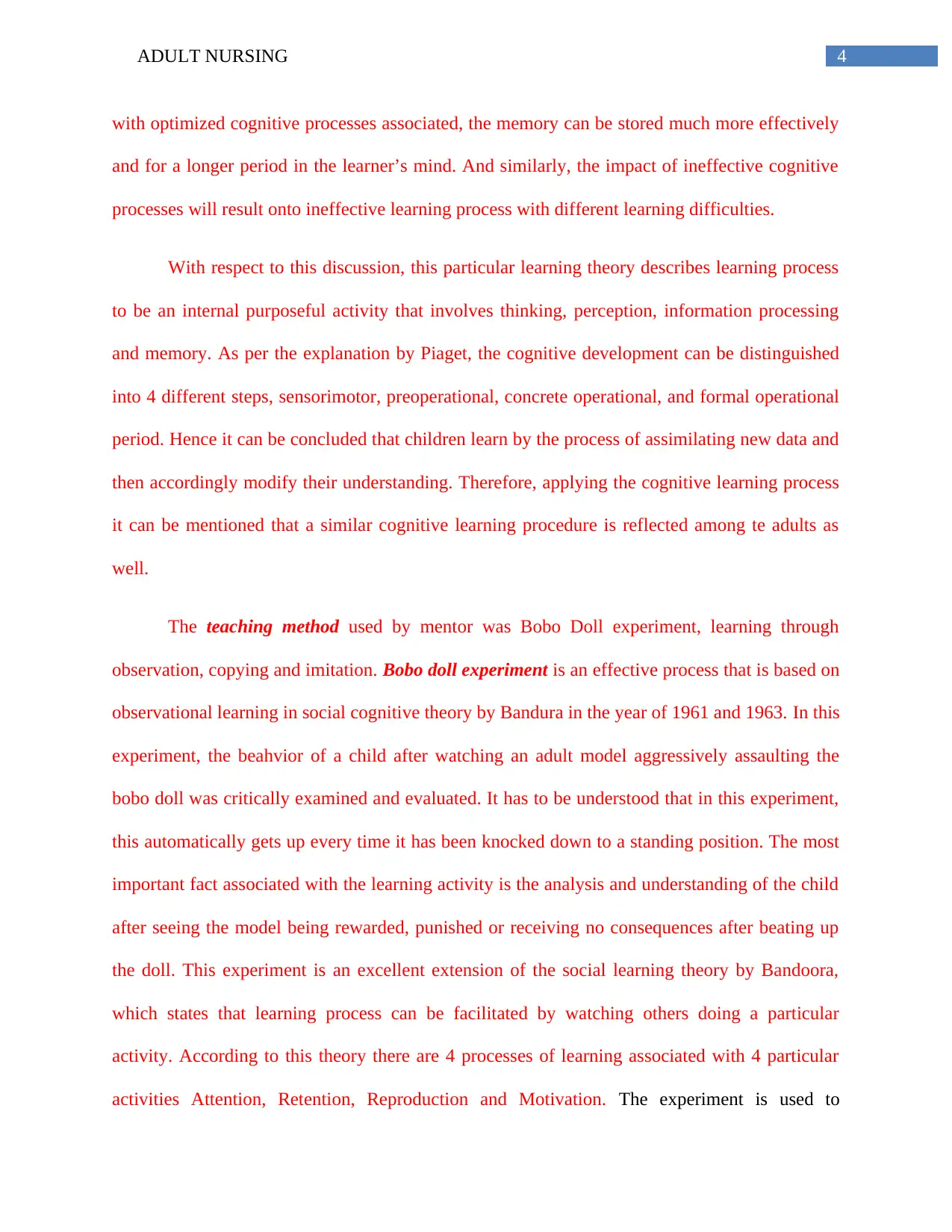
4ADULT NURSING
with optimized cognitive processes associated, the memory can be stored much more effectively
and for a longer period in the learner’s mind. And similarly, the impact of ineffective cognitive
processes will result onto ineffective learning process with different learning difficulties.
With respect to this discussion, this particular learning theory describes learning process
to be an internal purposeful activity that involves thinking, perception, information processing
and memory. As per the explanation by Piaget, the cognitive development can be distinguished
into 4 different steps, sensorimotor, preoperational, concrete operational, and formal operational
period. Hence it can be concluded that children learn by the process of assimilating new data and
then accordingly modify their understanding. Therefore, applying the cognitive learning process
it can be mentioned that a similar cognitive learning procedure is reflected among te adults as
well.
The teaching method used by mentor was Bobo Doll experiment, learning through
observation, copying and imitation. Bobo doll experiment is an effective process that is based on
observational learning in social cognitive theory by Bandura in the year of 1961 and 1963. In this
experiment, the beahvior of a child after watching an adult model aggressively assaulting the
bobo doll was critically examined and evaluated. It has to be understood that in this experiment,
this automatically gets up every time it has been knocked down to a standing position. The most
important fact associated with the learning activity is the analysis and understanding of the child
after seeing the model being rewarded, punished or receiving no consequences after beating up
the doll. This experiment is an excellent extension of the social learning theory by Bandoora,
which states that learning process can be facilitated by watching others doing a particular
activity. According to this theory there are 4 processes of learning associated with 4 particular
activities Attention, Retention, Reproduction and Motivation. The experiment is used to
with optimized cognitive processes associated, the memory can be stored much more effectively
and for a longer period in the learner’s mind. And similarly, the impact of ineffective cognitive
processes will result onto ineffective learning process with different learning difficulties.
With respect to this discussion, this particular learning theory describes learning process
to be an internal purposeful activity that involves thinking, perception, information processing
and memory. As per the explanation by Piaget, the cognitive development can be distinguished
into 4 different steps, sensorimotor, preoperational, concrete operational, and formal operational
period. Hence it can be concluded that children learn by the process of assimilating new data and
then accordingly modify their understanding. Therefore, applying the cognitive learning process
it can be mentioned that a similar cognitive learning procedure is reflected among te adults as
well.
The teaching method used by mentor was Bobo Doll experiment, learning through
observation, copying and imitation. Bobo doll experiment is an effective process that is based on
observational learning in social cognitive theory by Bandura in the year of 1961 and 1963. In this
experiment, the beahvior of a child after watching an adult model aggressively assaulting the
bobo doll was critically examined and evaluated. It has to be understood that in this experiment,
this automatically gets up every time it has been knocked down to a standing position. The most
important fact associated with the learning activity is the analysis and understanding of the child
after seeing the model being rewarded, punished or receiving no consequences after beating up
the doll. This experiment is an excellent extension of the social learning theory by Bandoora,
which states that learning process can be facilitated by watching others doing a particular
activity. According to this theory there are 4 processes of learning associated with 4 particular
activities Attention, Retention, Reproduction and Motivation. The experiment is used to
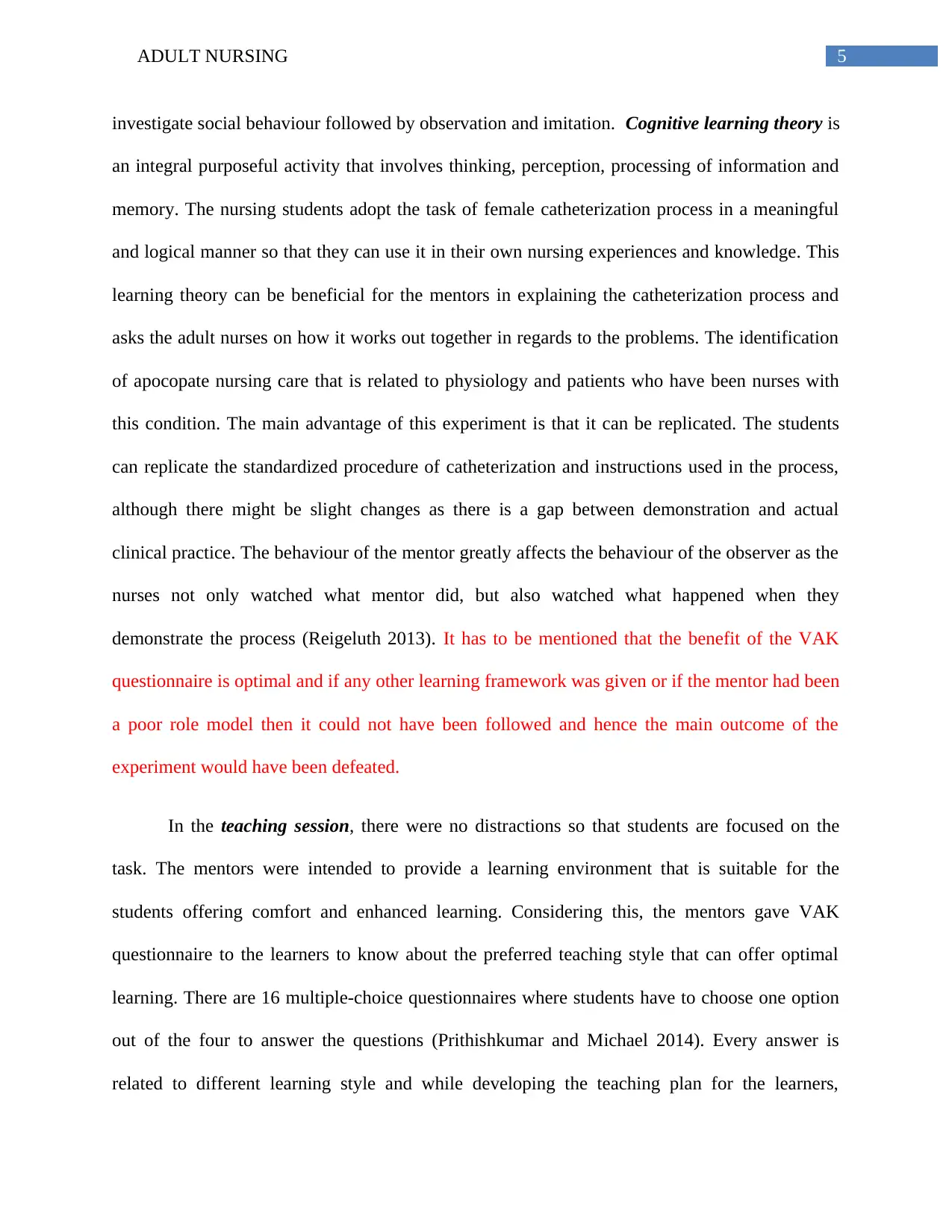
5ADULT NURSING
investigate social behaviour followed by observation and imitation. Cognitive learning theory is
an integral purposeful activity that involves thinking, perception, processing of information and
memory. The nursing students adopt the task of female catheterization process in a meaningful
and logical manner so that they can use it in their own nursing experiences and knowledge. This
learning theory can be beneficial for the mentors in explaining the catheterization process and
asks the adult nurses on how it works out together in regards to the problems. The identification
of apocopate nursing care that is related to physiology and patients who have been nurses with
this condition. The main advantage of this experiment is that it can be replicated. The students
can replicate the standardized procedure of catheterization and instructions used in the process,
although there might be slight changes as there is a gap between demonstration and actual
clinical practice. The behaviour of the mentor greatly affects the behaviour of the observer as the
nurses not only watched what mentor did, but also watched what happened when they
demonstrate the process (Reigeluth 2013). It has to be mentioned that the benefit of the VAK
questionnaire is optimal and if any other learning framework was given or if the mentor had been
a poor role model then it could not have been followed and hence the main outcome of the
experiment would have been defeated.
In the teaching session, there were no distractions so that students are focused on the
task. The mentors were intended to provide a learning environment that is suitable for the
students offering comfort and enhanced learning. Considering this, the mentors gave VAK
questionnaire to the learners to know about the preferred teaching style that can offer optimal
learning. There are 16 multiple-choice questionnaires where students have to choose one option
out of the four to answer the questions (Prithishkumar and Michael 2014). Every answer is
related to different learning style and while developing the teaching plan for the learners,
investigate social behaviour followed by observation and imitation. Cognitive learning theory is
an integral purposeful activity that involves thinking, perception, processing of information and
memory. The nursing students adopt the task of female catheterization process in a meaningful
and logical manner so that they can use it in their own nursing experiences and knowledge. This
learning theory can be beneficial for the mentors in explaining the catheterization process and
asks the adult nurses on how it works out together in regards to the problems. The identification
of apocopate nursing care that is related to physiology and patients who have been nurses with
this condition. The main advantage of this experiment is that it can be replicated. The students
can replicate the standardized procedure of catheterization and instructions used in the process,
although there might be slight changes as there is a gap between demonstration and actual
clinical practice. The behaviour of the mentor greatly affects the behaviour of the observer as the
nurses not only watched what mentor did, but also watched what happened when they
demonstrate the process (Reigeluth 2013). It has to be mentioned that the benefit of the VAK
questionnaire is optimal and if any other learning framework was given or if the mentor had been
a poor role model then it could not have been followed and hence the main outcome of the
experiment would have been defeated.
In the teaching session, there were no distractions so that students are focused on the
task. The mentors were intended to provide a learning environment that is suitable for the
students offering comfort and enhanced learning. Considering this, the mentors gave VAK
questionnaire to the learners to know about the preferred teaching style that can offer optimal
learning. There are 16 multiple-choice questionnaires where students have to choose one option
out of the four to answer the questions (Prithishkumar and Michael 2014). Every answer is
related to different learning style and while developing the teaching plan for the learners,
⊘ This is a preview!⊘
Do you want full access?
Subscribe today to unlock all pages.

Trusted by 1+ million students worldwide
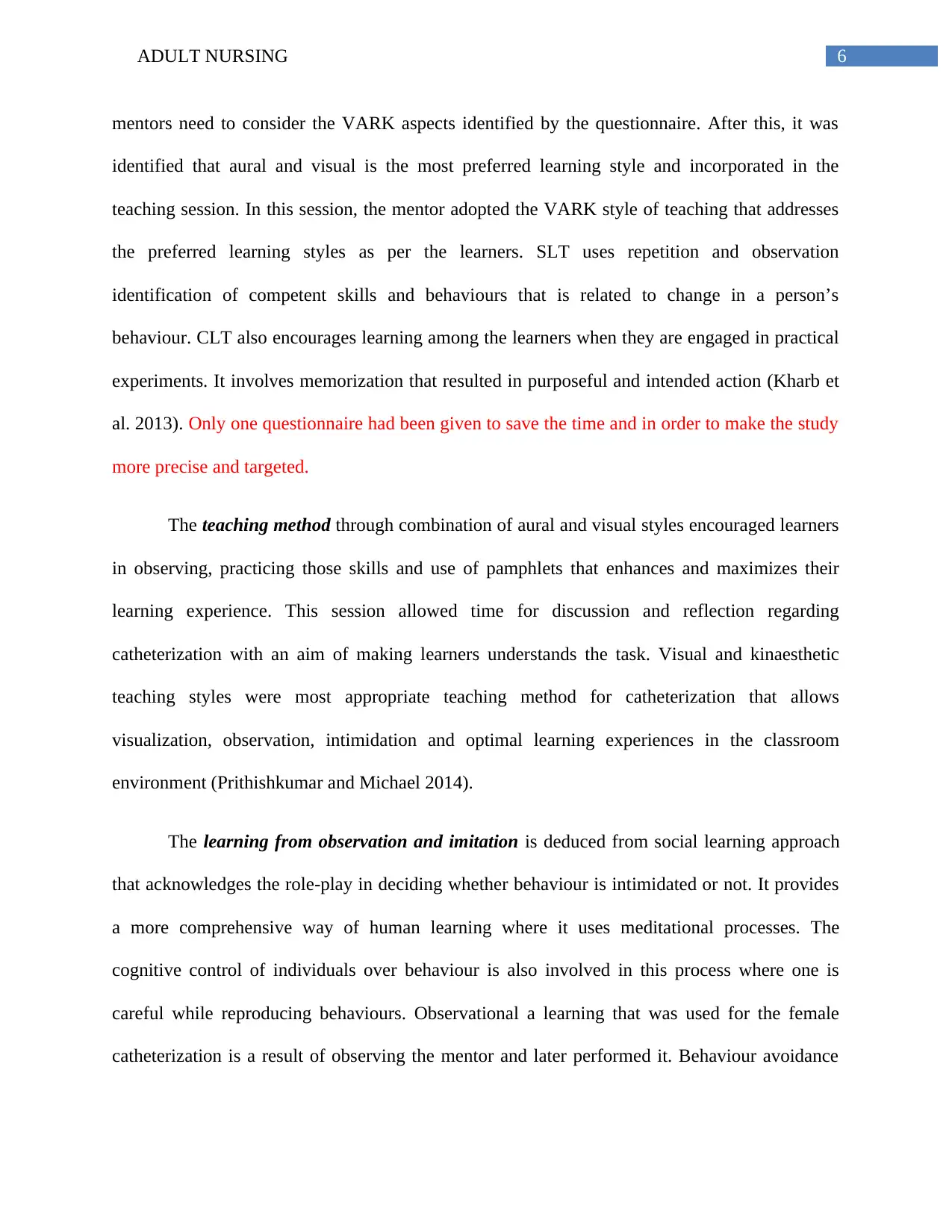
6ADULT NURSING
mentors need to consider the VARK aspects identified by the questionnaire. After this, it was
identified that aural and visual is the most preferred learning style and incorporated in the
teaching session. In this session, the mentor adopted the VARK style of teaching that addresses
the preferred learning styles as per the learners. SLT uses repetition and observation
identification of competent skills and behaviours that is related to change in a person’s
behaviour. CLT also encourages learning among the learners when they are engaged in practical
experiments. It involves memorization that resulted in purposeful and intended action (Kharb et
al. 2013). Only one questionnaire had been given to save the time and in order to make the study
more precise and targeted.
The teaching method through combination of aural and visual styles encouraged learners
in observing, practicing those skills and use of pamphlets that enhances and maximizes their
learning experience. This session allowed time for discussion and reflection regarding
catheterization with an aim of making learners understands the task. Visual and kinaesthetic
teaching styles were most appropriate teaching method for catheterization that allows
visualization, observation, intimidation and optimal learning experiences in the classroom
environment (Prithishkumar and Michael 2014).
The learning from observation and imitation is deduced from social learning approach
that acknowledges the role-play in deciding whether behaviour is intimidated or not. It provides
a more comprehensive way of human learning where it uses meditational processes. The
cognitive control of individuals over behaviour is also involved in this process where one is
careful while reproducing behaviours. Observational a learning that was used for the female
catheterization is a result of observing the mentor and later performed it. Behaviour avoidance
mentors need to consider the VARK aspects identified by the questionnaire. After this, it was
identified that aural and visual is the most preferred learning style and incorporated in the
teaching session. In this session, the mentor adopted the VARK style of teaching that addresses
the preferred learning styles as per the learners. SLT uses repetition and observation
identification of competent skills and behaviours that is related to change in a person’s
behaviour. CLT also encourages learning among the learners when they are engaged in practical
experiments. It involves memorization that resulted in purposeful and intended action (Kharb et
al. 2013). Only one questionnaire had been given to save the time and in order to make the study
more precise and targeted.
The teaching method through combination of aural and visual styles encouraged learners
in observing, practicing those skills and use of pamphlets that enhances and maximizes their
learning experience. This session allowed time for discussion and reflection regarding
catheterization with an aim of making learners understands the task. Visual and kinaesthetic
teaching styles were most appropriate teaching method for catheterization that allows
visualization, observation, intimidation and optimal learning experiences in the classroom
environment (Prithishkumar and Michael 2014).
The learning from observation and imitation is deduced from social learning approach
that acknowledges the role-play in deciding whether behaviour is intimidated or not. It provides
a more comprehensive way of human learning where it uses meditational processes. The
cognitive control of individuals over behaviour is also involved in this process where one is
careful while reproducing behaviours. Observational a learning that was used for the female
catheterization is a result of observing the mentor and later performed it. Behaviour avoidance
Paraphrase This Document
Need a fresh take? Get an instant paraphrase of this document with our AI Paraphraser
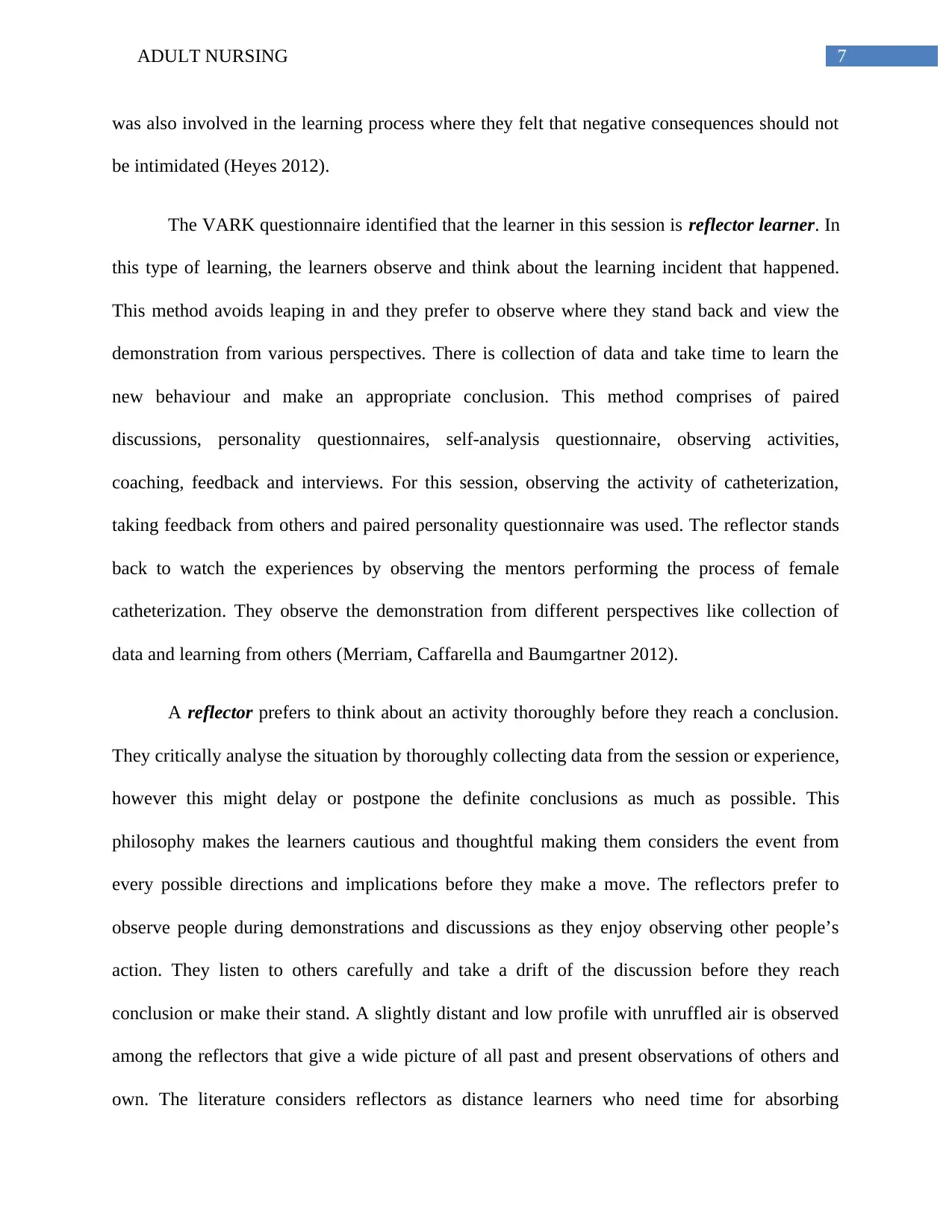
7ADULT NURSING
was also involved in the learning process where they felt that negative consequences should not
be intimidated (Heyes 2012).
The VARK questionnaire identified that the learner in this session is reflector learner. In
this type of learning, the learners observe and think about the learning incident that happened.
This method avoids leaping in and they prefer to observe where they stand back and view the
demonstration from various perspectives. There is collection of data and take time to learn the
new behaviour and make an appropriate conclusion. This method comprises of paired
discussions, personality questionnaires, self-analysis questionnaire, observing activities,
coaching, feedback and interviews. For this session, observing the activity of catheterization,
taking feedback from others and paired personality questionnaire was used. The reflector stands
back to watch the experiences by observing the mentors performing the process of female
catheterization. They observe the demonstration from different perspectives like collection of
data and learning from others (Merriam, Caffarella and Baumgartner 2012).
A reflector prefers to think about an activity thoroughly before they reach a conclusion.
They critically analyse the situation by thoroughly collecting data from the session or experience,
however this might delay or postpone the definite conclusions as much as possible. This
philosophy makes the learners cautious and thoughtful making them considers the event from
every possible directions and implications before they make a move. The reflectors prefer to
observe people during demonstrations and discussions as they enjoy observing other people’s
action. They listen to others carefully and take a drift of the discussion before they reach
conclusion or make their stand. A slightly distant and low profile with unruffled air is observed
among the reflectors that give a wide picture of all past and present observations of others and
own. The literature considers reflectors as distance learners who need time for absorbing
was also involved in the learning process where they felt that negative consequences should not
be intimidated (Heyes 2012).
The VARK questionnaire identified that the learner in this session is reflector learner. In
this type of learning, the learners observe and think about the learning incident that happened.
This method avoids leaping in and they prefer to observe where they stand back and view the
demonstration from various perspectives. There is collection of data and take time to learn the
new behaviour and make an appropriate conclusion. This method comprises of paired
discussions, personality questionnaires, self-analysis questionnaire, observing activities,
coaching, feedback and interviews. For this session, observing the activity of catheterization,
taking feedback from others and paired personality questionnaire was used. The reflector stands
back to watch the experiences by observing the mentors performing the process of female
catheterization. They observe the demonstration from different perspectives like collection of
data and learning from others (Merriam, Caffarella and Baumgartner 2012).
A reflector prefers to think about an activity thoroughly before they reach a conclusion.
They critically analyse the situation by thoroughly collecting data from the session or experience,
however this might delay or postpone the definite conclusions as much as possible. This
philosophy makes the learners cautious and thoughtful making them considers the event from
every possible directions and implications before they make a move. The reflectors prefer to
observe people during demonstrations and discussions as they enjoy observing other people’s
action. They listen to others carefully and take a drift of the discussion before they reach
conclusion or make their stand. A slightly distant and low profile with unruffled air is observed
among the reflectors that give a wide picture of all past and present observations of others and
own. The literature considers reflectors as distance learners who need time for absorbing
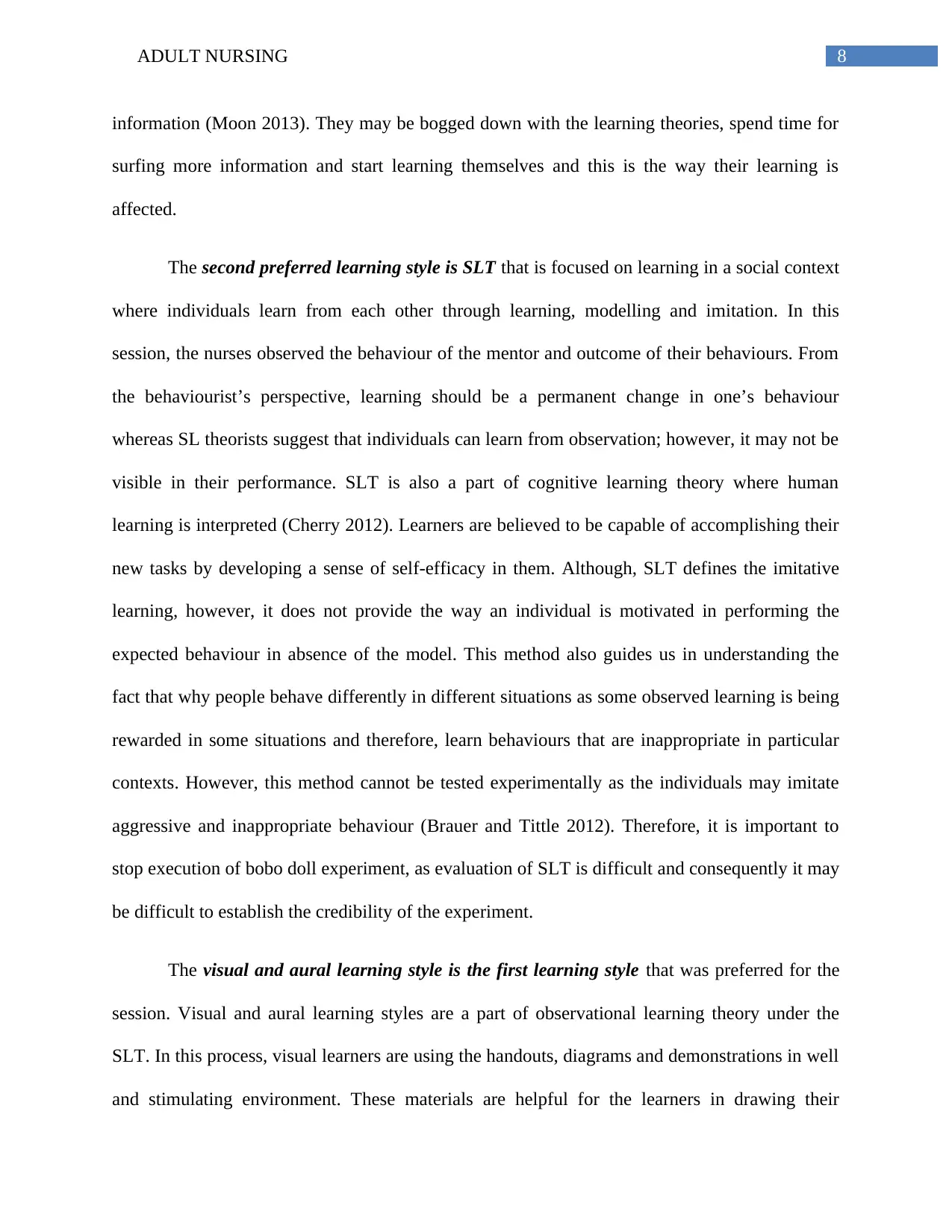
8ADULT NURSING
information (Moon 2013). They may be bogged down with the learning theories, spend time for
surfing more information and start learning themselves and this is the way their learning is
affected.
The second preferred learning style is SLT that is focused on learning in a social context
where individuals learn from each other through learning, modelling and imitation. In this
session, the nurses observed the behaviour of the mentor and outcome of their behaviours. From
the behaviourist’s perspective, learning should be a permanent change in one’s behaviour
whereas SL theorists suggest that individuals can learn from observation; however, it may not be
visible in their performance. SLT is also a part of cognitive learning theory where human
learning is interpreted (Cherry 2012). Learners are believed to be capable of accomplishing their
new tasks by developing a sense of self-efficacy in them. Although, SLT defines the imitative
learning, however, it does not provide the way an individual is motivated in performing the
expected behaviour in absence of the model. This method also guides us in understanding the
fact that why people behave differently in different situations as some observed learning is being
rewarded in some situations and therefore, learn behaviours that are inappropriate in particular
contexts. However, this method cannot be tested experimentally as the individuals may imitate
aggressive and inappropriate behaviour (Brauer and Tittle 2012). Therefore, it is important to
stop execution of bobo doll experiment, as evaluation of SLT is difficult and consequently it may
be difficult to establish the credibility of the experiment.
The visual and aural learning style is the first learning style that was preferred for the
session. Visual and aural learning styles are a part of observational learning theory under the
SLT. In this process, visual learners are using the handouts, diagrams and demonstrations in well
and stimulating environment. These materials are helpful for the learners in drawing their
information (Moon 2013). They may be bogged down with the learning theories, spend time for
surfing more information and start learning themselves and this is the way their learning is
affected.
The second preferred learning style is SLT that is focused on learning in a social context
where individuals learn from each other through learning, modelling and imitation. In this
session, the nurses observed the behaviour of the mentor and outcome of their behaviours. From
the behaviourist’s perspective, learning should be a permanent change in one’s behaviour
whereas SL theorists suggest that individuals can learn from observation; however, it may not be
visible in their performance. SLT is also a part of cognitive learning theory where human
learning is interpreted (Cherry 2012). Learners are believed to be capable of accomplishing their
new tasks by developing a sense of self-efficacy in them. Although, SLT defines the imitative
learning, however, it does not provide the way an individual is motivated in performing the
expected behaviour in absence of the model. This method also guides us in understanding the
fact that why people behave differently in different situations as some observed learning is being
rewarded in some situations and therefore, learn behaviours that are inappropriate in particular
contexts. However, this method cannot be tested experimentally as the individuals may imitate
aggressive and inappropriate behaviour (Brauer and Tittle 2012). Therefore, it is important to
stop execution of bobo doll experiment, as evaluation of SLT is difficult and consequently it may
be difficult to establish the credibility of the experiment.
The visual and aural learning style is the first learning style that was preferred for the
session. Visual and aural learning styles are a part of observational learning theory under the
SLT. In this process, visual learners are using the handouts, diagrams and demonstrations in well
and stimulating environment. These materials are helpful for the learners in drawing their
⊘ This is a preview!⊘
Do you want full access?
Subscribe today to unlock all pages.

Trusted by 1+ million students worldwide
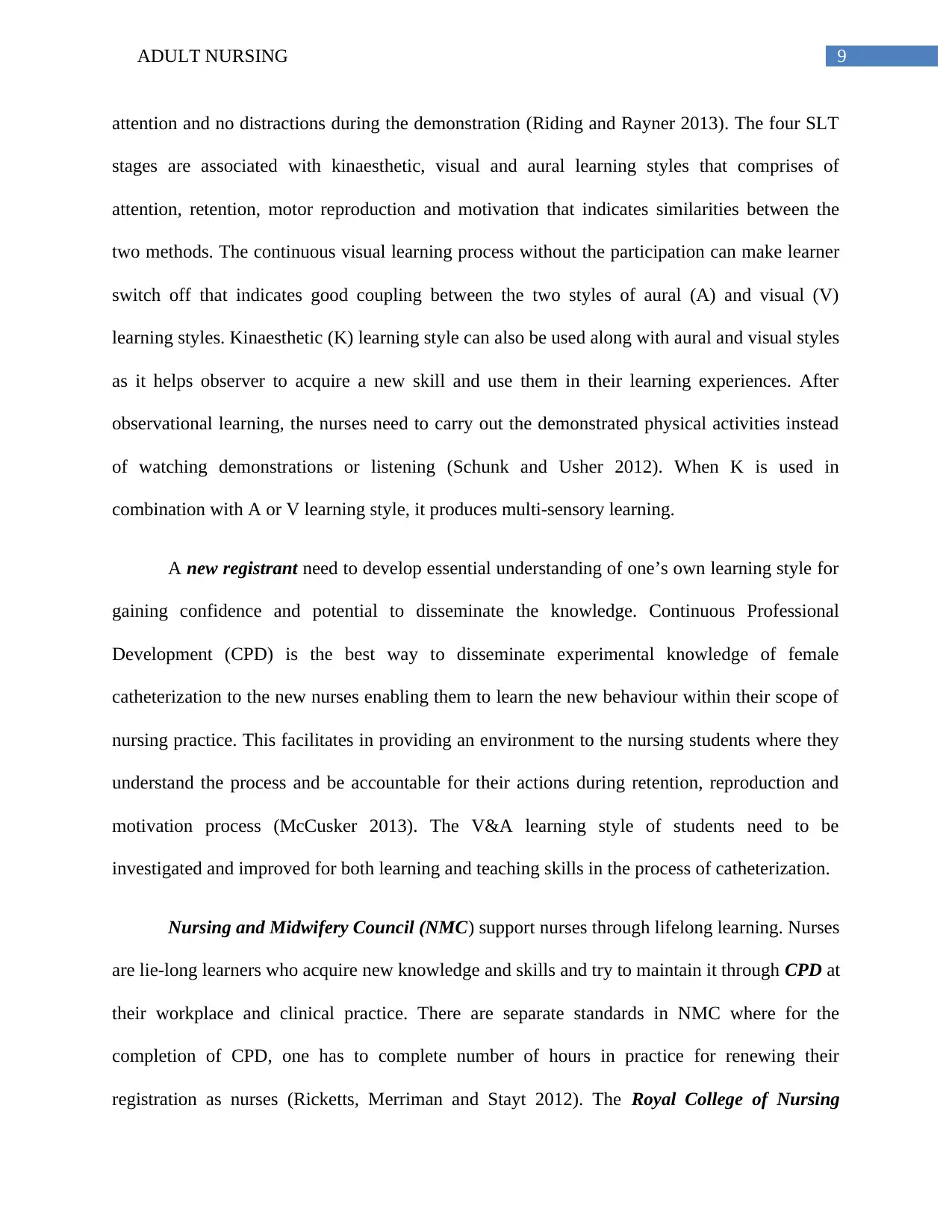
9ADULT NURSING
attention and no distractions during the demonstration (Riding and Rayner 2013). The four SLT
stages are associated with kinaesthetic, visual and aural learning styles that comprises of
attention, retention, motor reproduction and motivation that indicates similarities between the
two methods. The continuous visual learning process without the participation can make learner
switch off that indicates good coupling between the two styles of aural (A) and visual (V)
learning styles. Kinaesthetic (K) learning style can also be used along with aural and visual styles
as it helps observer to acquire a new skill and use them in their learning experiences. After
observational learning, the nurses need to carry out the demonstrated physical activities instead
of watching demonstrations or listening (Schunk and Usher 2012). When K is used in
combination with A or V learning style, it produces multi-sensory learning.
A new registrant need to develop essential understanding of one’s own learning style for
gaining confidence and potential to disseminate the knowledge. Continuous Professional
Development (CPD) is the best way to disseminate experimental knowledge of female
catheterization to the new nurses enabling them to learn the new behaviour within their scope of
nursing practice. This facilitates in providing an environment to the nursing students where they
understand the process and be accountable for their actions during retention, reproduction and
motivation process (McCusker 2013). The V&A learning style of students need to be
investigated and improved for both learning and teaching skills in the process of catheterization.
Nursing and Midwifery Council (NMC) support nurses through lifelong learning. Nurses
are lie-long learners who acquire new knowledge and skills and try to maintain it through CPD at
their workplace and clinical practice. There are separate standards in NMC where for the
completion of CPD, one has to complete number of hours in practice for renewing their
registration as nurses (Ricketts, Merriman and Stayt 2012). The Royal College of Nursing
attention and no distractions during the demonstration (Riding and Rayner 2013). The four SLT
stages are associated with kinaesthetic, visual and aural learning styles that comprises of
attention, retention, motor reproduction and motivation that indicates similarities between the
two methods. The continuous visual learning process without the participation can make learner
switch off that indicates good coupling between the two styles of aural (A) and visual (V)
learning styles. Kinaesthetic (K) learning style can also be used along with aural and visual styles
as it helps observer to acquire a new skill and use them in their learning experiences. After
observational learning, the nurses need to carry out the demonstrated physical activities instead
of watching demonstrations or listening (Schunk and Usher 2012). When K is used in
combination with A or V learning style, it produces multi-sensory learning.
A new registrant need to develop essential understanding of one’s own learning style for
gaining confidence and potential to disseminate the knowledge. Continuous Professional
Development (CPD) is the best way to disseminate experimental knowledge of female
catheterization to the new nurses enabling them to learn the new behaviour within their scope of
nursing practice. This facilitates in providing an environment to the nursing students where they
understand the process and be accountable for their actions during retention, reproduction and
motivation process (McCusker 2013). The V&A learning style of students need to be
investigated and improved for both learning and teaching skills in the process of catheterization.
Nursing and Midwifery Council (NMC) support nurses through lifelong learning. Nurses
are lie-long learners who acquire new knowledge and skills and try to maintain it through CPD at
their workplace and clinical practice. There are separate standards in NMC where for the
completion of CPD, one has to complete number of hours in practice for renewing their
registration as nurses (Ricketts, Merriman and Stayt 2012). The Royal College of Nursing
Paraphrase This Document
Need a fresh take? Get an instant paraphrase of this document with our AI Paraphraser
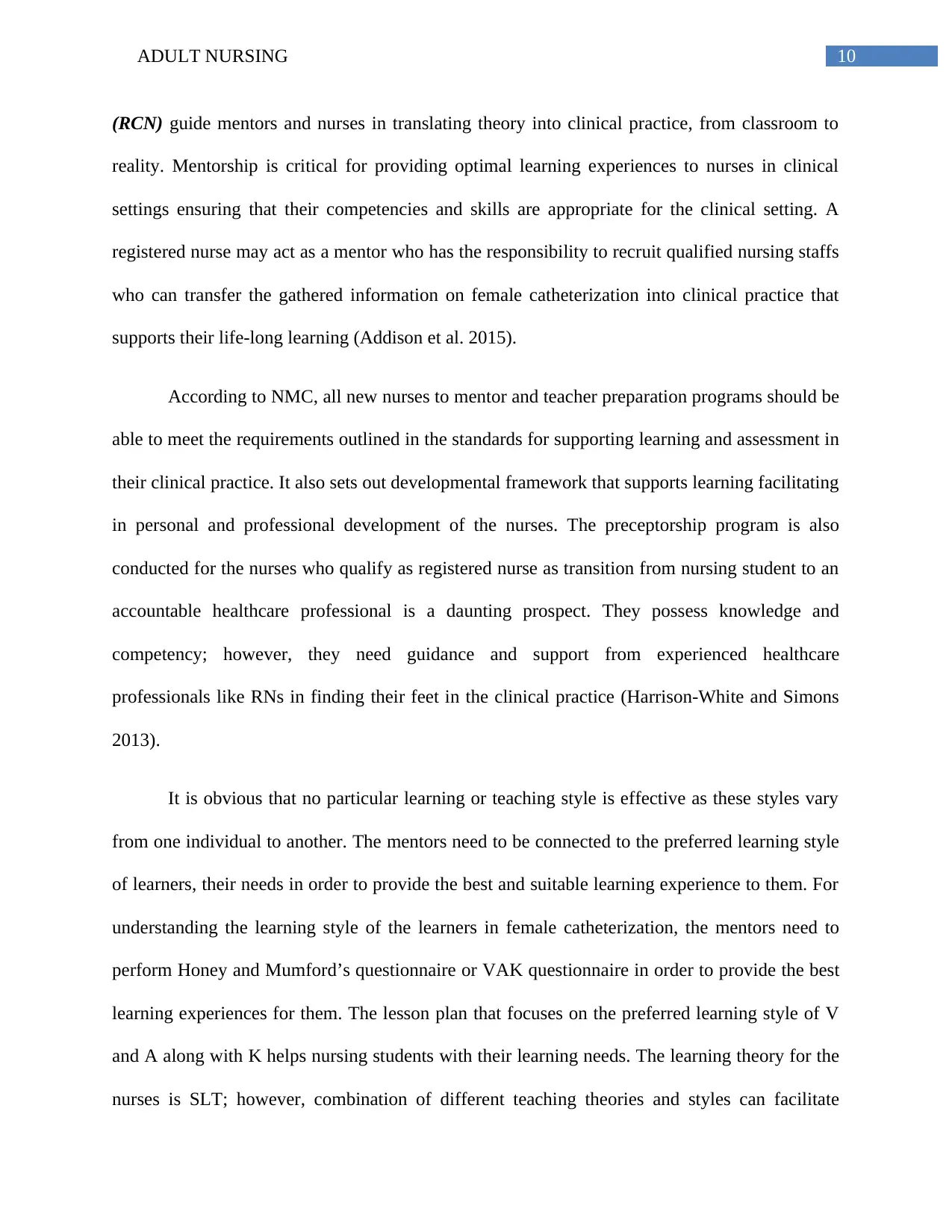
10ADULT NURSING
(RCN) guide mentors and nurses in translating theory into clinical practice, from classroom to
reality. Mentorship is critical for providing optimal learning experiences to nurses in clinical
settings ensuring that their competencies and skills are appropriate for the clinical setting. A
registered nurse may act as a mentor who has the responsibility to recruit qualified nursing staffs
who can transfer the gathered information on female catheterization into clinical practice that
supports their life-long learning (Addison et al. 2015).
According to NMC, all new nurses to mentor and teacher preparation programs should be
able to meet the requirements outlined in the standards for supporting learning and assessment in
their clinical practice. It also sets out developmental framework that supports learning facilitating
in personal and professional development of the nurses. The preceptorship program is also
conducted for the nurses who qualify as registered nurse as transition from nursing student to an
accountable healthcare professional is a daunting prospect. They possess knowledge and
competency; however, they need guidance and support from experienced healthcare
professionals like RNs in finding their feet in the clinical practice (Harrison-White and Simons
2013).
It is obvious that no particular learning or teaching style is effective as these styles vary
from one individual to another. The mentors need to be connected to the preferred learning style
of learners, their needs in order to provide the best and suitable learning experience to them. For
understanding the learning style of the learners in female catheterization, the mentors need to
perform Honey and Mumford’s questionnaire or VAK questionnaire in order to provide the best
learning experiences for them. The lesson plan that focuses on the preferred learning style of V
and A along with K helps nursing students with their learning needs. The learning theory for the
nurses is SLT; however, combination of different teaching theories and styles can facilitate
(RCN) guide mentors and nurses in translating theory into clinical practice, from classroom to
reality. Mentorship is critical for providing optimal learning experiences to nurses in clinical
settings ensuring that their competencies and skills are appropriate for the clinical setting. A
registered nurse may act as a mentor who has the responsibility to recruit qualified nursing staffs
who can transfer the gathered information on female catheterization into clinical practice that
supports their life-long learning (Addison et al. 2015).
According to NMC, all new nurses to mentor and teacher preparation programs should be
able to meet the requirements outlined in the standards for supporting learning and assessment in
their clinical practice. It also sets out developmental framework that supports learning facilitating
in personal and professional development of the nurses. The preceptorship program is also
conducted for the nurses who qualify as registered nurse as transition from nursing student to an
accountable healthcare professional is a daunting prospect. They possess knowledge and
competency; however, they need guidance and support from experienced healthcare
professionals like RNs in finding their feet in the clinical practice (Harrison-White and Simons
2013).
It is obvious that no particular learning or teaching style is effective as these styles vary
from one individual to another. The mentors need to be connected to the preferred learning style
of learners, their needs in order to provide the best and suitable learning experience to them. For
understanding the learning style of the learners in female catheterization, the mentors need to
perform Honey and Mumford’s questionnaire or VAK questionnaire in order to provide the best
learning experiences for them. The lesson plan that focuses on the preferred learning style of V
and A along with K helps nursing students with their learning needs. The learning theory for the
nurses is SLT; however, combination of different teaching theories and styles can facilitate
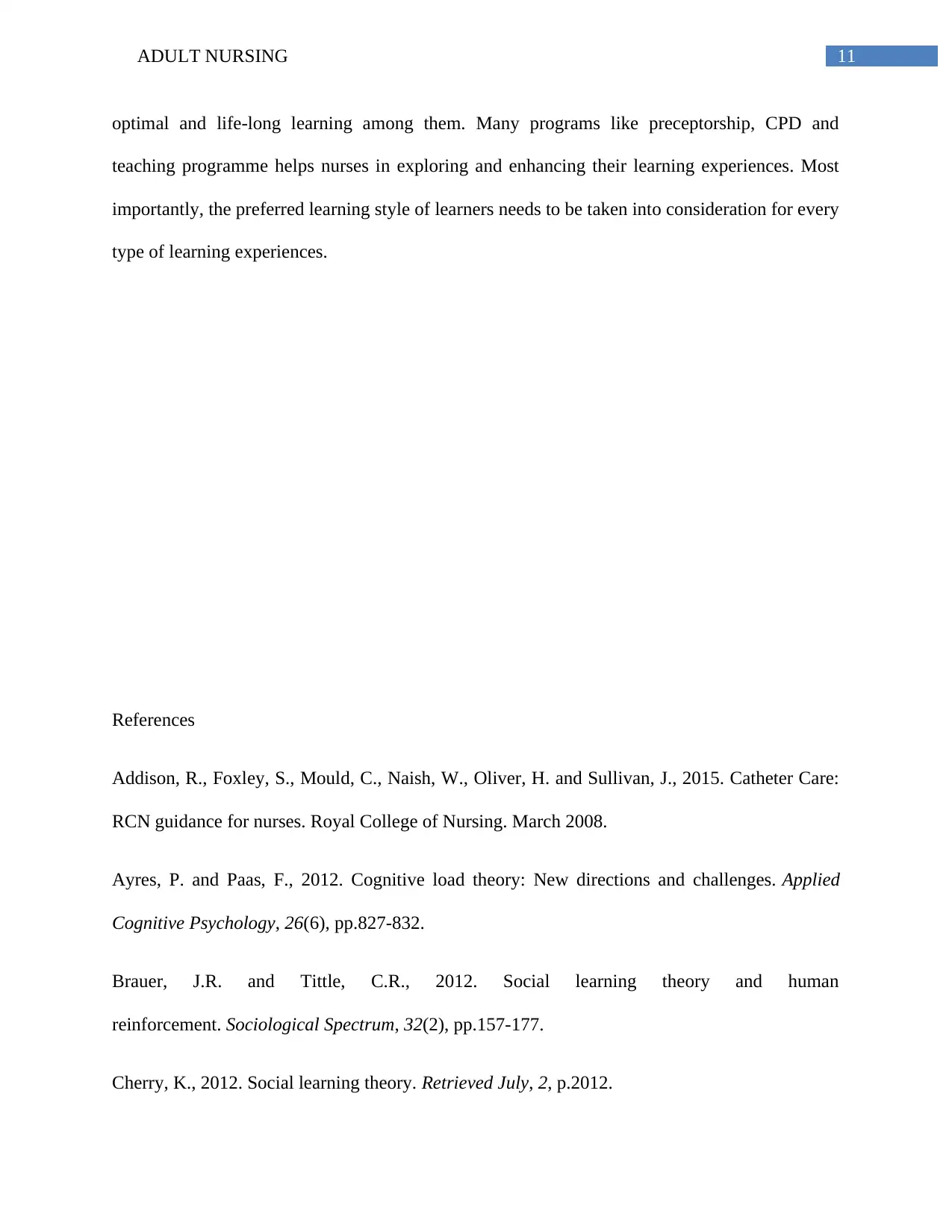
11ADULT NURSING
optimal and life-long learning among them. Many programs like preceptorship, CPD and
teaching programme helps nurses in exploring and enhancing their learning experiences. Most
importantly, the preferred learning style of learners needs to be taken into consideration for every
type of learning experiences.
References
Addison, R., Foxley, S., Mould, C., Naish, W., Oliver, H. and Sullivan, J., 2015. Catheter Care:
RCN guidance for nurses. Royal College of Nursing. March 2008.
Ayres, P. and Paas, F., 2012. Cognitive load theory: New directions and challenges. Applied
Cognitive Psychology, 26(6), pp.827-832.
Brauer, J.R. and Tittle, C.R., 2012. Social learning theory and human
reinforcement. Sociological Spectrum, 32(2), pp.157-177.
Cherry, K., 2012. Social learning theory. Retrieved July, 2, p.2012.
optimal and life-long learning among them. Many programs like preceptorship, CPD and
teaching programme helps nurses in exploring and enhancing their learning experiences. Most
importantly, the preferred learning style of learners needs to be taken into consideration for every
type of learning experiences.
References
Addison, R., Foxley, S., Mould, C., Naish, W., Oliver, H. and Sullivan, J., 2015. Catheter Care:
RCN guidance for nurses. Royal College of Nursing. March 2008.
Ayres, P. and Paas, F., 2012. Cognitive load theory: New directions and challenges. Applied
Cognitive Psychology, 26(6), pp.827-832.
Brauer, J.R. and Tittle, C.R., 2012. Social learning theory and human
reinforcement. Sociological Spectrum, 32(2), pp.157-177.
Cherry, K., 2012. Social learning theory. Retrieved July, 2, p.2012.
⊘ This is a preview!⊘
Do you want full access?
Subscribe today to unlock all pages.

Trusted by 1+ million students worldwide
1 out of 18
Related Documents
Your All-in-One AI-Powered Toolkit for Academic Success.
+13062052269
info@desklib.com
Available 24*7 on WhatsApp / Email
![[object Object]](/_next/static/media/star-bottom.7253800d.svg)
Unlock your academic potential
Copyright © 2020–2025 A2Z Services. All Rights Reserved. Developed and managed by ZUCOL.





